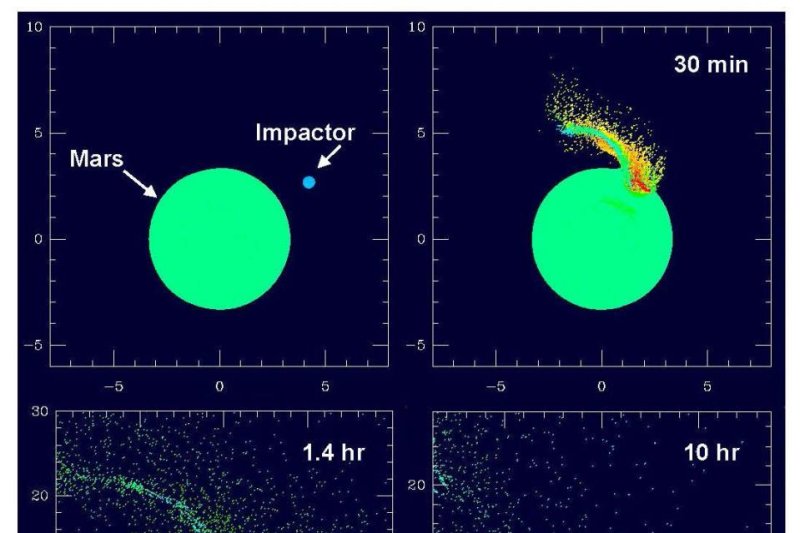The impact that forged Mars' moons was made by an asteroid measuring between 326 miles and 587 miles wide. Photo by Southwest Research Institute
April 18 (UPI) -- The Martian moons Phobos and Deimos were formed after a large object struck the Red Planet a few billion years ago, according to a new model developed by scientists at the Southwest Research Institute.
Scientists have considered a number of origin scenarios for Phobos and Deimos, including the possibility that the satellites are asteroids captured by Mars' gravity.
The most promising formation theory is one involving an impact and an equatorial disk of debris. The two small moons formed from the disk of rocky fragments. But until now, attempts to model such a scenario have failed to convince.
"Ours is the first self-consistent model to identify the type of impact needed to lead to the formation of Mars' two small moons," Robin Canup, an associate vice president in the SwRI Space Science and Engineering Division, said in a news release.
Researchers believe the impact that carved out Mars' moons was similar to the impact event that yielded Earth's moon -- but on a smaller scale. Scientists believe the object that struck the Red Planet was between 326 miles and 587 miles wide.
"A key result of the new work is the size of the impactor; we find that a large impactor -- similar in size to the largest asteroids Vesta and Ceres -- is needed, rather than a giant impactor," Canup said. "The model also predicts that the two moons are derived primarily from material originating in Mars, so their bulk compositions should be similar to that of Mars for most elements."
Because the impact would have produced extreme temperatures and Mars' gravity is relatively weak, water vapor would likely been lost during the impact. Thus, if the new model is accurate, Phobos and Deimos are dry.
Scientists shared their model and its predictions in a new paper published this week in the journal Science Advances.
Previous models have considered much larger impact events, but a larger impact would have yielded larger moons. Under such a scenario, moons the size of Phobos and Deimos would have been destroyed.
The Japan Aerospace Exploration Agency, JAXA, has plans to launch a mission to visit Mars' two moons. The Mars Moons eXploration mission is scheduled to launch in 2024. The spacecraft will visit Deimos and land on Phobos. Researchers hope evidence and observations collected by MMX will help scientists better understand how the two moons formed and evolved.
"A primary objective of the MMX mission is to determine the origin of Mars' moons, and having a model that predicts what the moons compositions would be if they formed by impact provides a key constraint for achieving that goal," Canup said.















